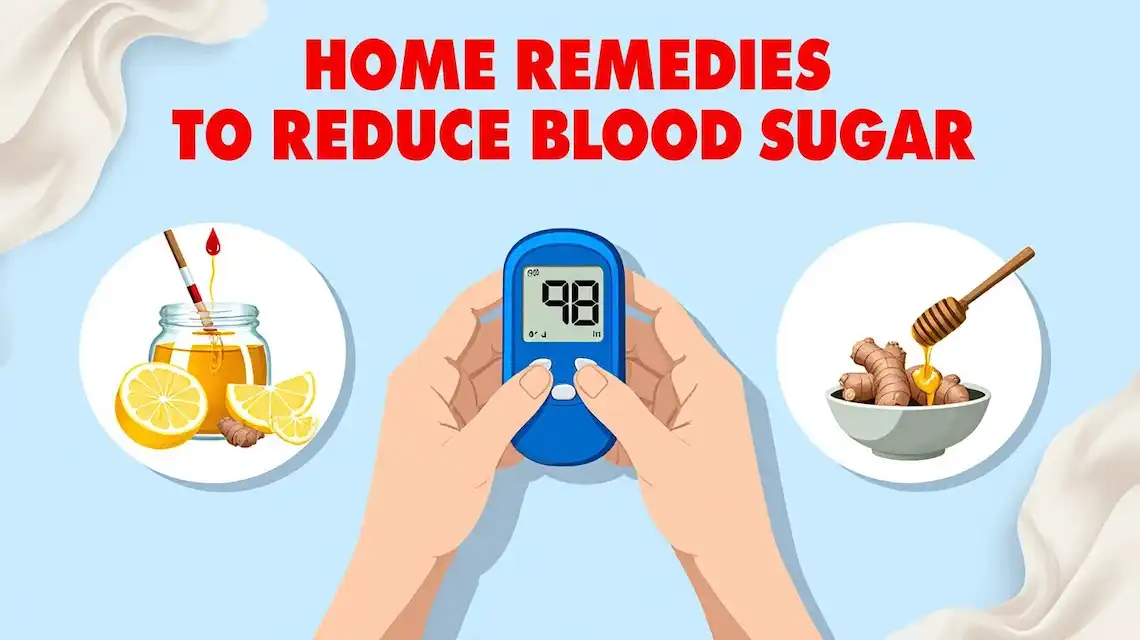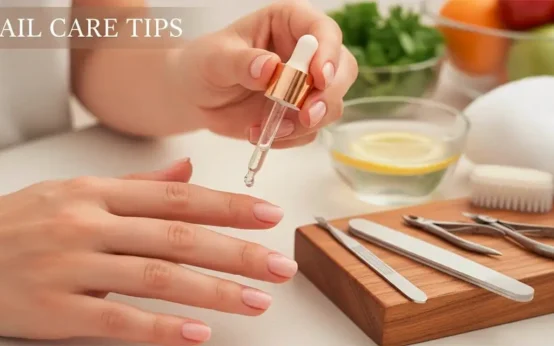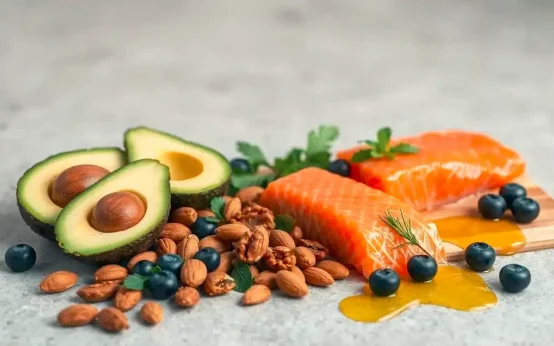Do your energy levels crash after meals? Stable glucose supports steady energy, easier weight control, and long term heart and brain health. The good news, simple daily choices and natural remedies to reduce blood sugar can move your numbers in the right direction.
This guide shows what works: smart food swaps, timing tricks, movement after meals, sleep and stress steps, plus a look at herbs and supplements with actual evidence. You will also get a short starter plan to try this week.
This is not a cure. It is a safe, step by step approach that pairs best with medical care. If you use insulin or sulfonylureas, check with your clinician before adding new steps, and monitor closely. Ready to feel steadier?
Blood sugar basics: how natural remedies help and what numbers to aim for
Carbs break down into glucose. Your gut absorbs that glucose into the blood. Insulin, a hormone from the pancreas, helps move glucose from the blood into your cells. When cells stop responding well to insulin, often called insulin resistance, blood sugar can stay high.
What causes spikes? Big portions of refined carbs, fast eating, and drinks with sugar. Sitting for long periods makes it worse. Poor sleep and stress hormones push glucose higher, even if food stays the same.
You can take control with small steps. Fiber and protein slow the rise. Short walks after meals help muscles soak up glucose. Better sleep and a calmer mind also help your numbers.
Here are simple targets many clinicians use. These are general ranges, so confirm yours with your care team.
| Situation | With Diabetes (ask your doctor) | Without Diabetes |
|---|---|---|
| Fasting (before breakfast) | 80 to 130 mg/dL | 70 to 99 mg/dL |
| 1 to 2 hours after starting a meal | Under 180 mg/dL | Under 140 mg/dL |
A glucometer gives spot checks. A continuous glucose monitor (CGM) shows trends. Testing fasting and after meals can teach you which foods or habits help.
Important safety note: if you take glucose lowering medicine, add natural steps slowly and watch for lows. Track your readings and share them with your clinician.
What raises and lowers blood sugar in your day
- Meal size and speed of carbs: big bowls of white rice or white bread hit fast, beans and vegetables slow the rise.
- Fiber: more fiber means a slower glucose curve.
- Protein and fat: both steady digestion and blunt spikes.
- Movement: even 10 minutes after meals helps muscles use glucose.
- Stress hormones: cortisol and adrenaline can raise blood sugar.
- Sleep: short or broken sleep makes insulin work less well.
Safe ranges and how to check at home
Test fasting, and again 1 to 2 hours after your first bite. Use those numbers to learn. Compare breakfast A to breakfast B. See how a 10 minute walk changes your reading. Log time, food, portion, and result in a simple note or app.
Goals vary by age, pregnancy, meds, and health. Confirm targets with your clinician. Look for patterns, not perfection.
Safety first if you take diabetes medicine
Mixing supplements or movement with insulin or sulfonylureas can cause lows. Know the signs: shakiness, sweating, fast heartbeat, blurred vision, irritability, confusion. Carry a quick sugar source if your clinician recommends it.
Talk with your clinician or pharmacist before adding supplements like berberine, cinnamon, or bitter melon. Start one change at a time, and track carefully.
Quick wins you can try today
- Drink water with each meal and between meals.
- Eat protein and veggies first, then carbs last.
- Take a 10 to 15 minute walk after meals.
- Swap soda for sparkling water with lime.
- Add a small side salad with vinaigrette before a carb heavy dish.
Eat to lower glucose: simple food swaps and smart meal timing
You do not need a perfect diet. You need a repeatable plan. Build most meals around a balanced plate. Fill half with non starchy vegetables, add a palm of protein, a thumb of healthy fat, and a cupped hand of higher fiber carbs. This combo slows digestion and smooths your glucose curve.
Protein and fiber keep you full, so portions stay in check. Healthy fats add flavor and help you absorb fat soluble vitamins. Whole food carbs give you slow energy.
Timing matters. Eat at steady times. Try not to skip all day and overeat at night. If eating out, start with a green salad and choose a protein heavy main. Ask for sauces on the side. Finish your meal with a short walk if you can.
Fill half your plate with fiber rich, non starchy veggies
Think leafy greens, broccoli, cauliflower, peppers, cucumbers, tomatoes, zucchini, asparagus, mushrooms. These add volume and fiber without a big glucose load.
Fiber helps you feel full and slows glucose entry into the blood. Roast veggies with olive oil and spices, stir fry in a little oil, or build crisp raw salads. Beans and lentils belong here too. They are higher fiber carb choices that lower the glycemic load and come with plant protein.
Choose low glycemic carbs that keep you steady
Smart swaps keep you satisfied without the spike.
- Oats or quinoa instead of white rice.
- Whole fruit, like berries or apples, instead of juice.
- Whole grain bread with nuts or seeds instead of white bread.
- Sweet potatoes instead of fries.
- Chickpea or lentil pasta instead of refined pasta.
Soaking and cooling cooked rice or potatoes can increase resistant starch, which may blunt spikes. You can reheat them later and still keep some of that effect.
Pair protein and healthy fats to blunt spikes
Protein and fat slow digestion, so glucose rises more gently. Easy options include eggs, Greek yogurt, tofu, chicken, fish, beans, nuts, seeds, olive oil, and avocado.
Quick breakfasts:
- Veggie omelet with salsa.
- Greek yogurt with chia and berries.
- Cottage cheese with cinnamon and walnuts.
Watch portions for fats since calories add up fast. A thumb or two of healthy fat per meal is plenty for most people.
Smart timing: order of eating and portions that work
Eat protein and veggies first, then enjoy carbs last. A small green salad with olive oil or vinegar before the main course can help. Keep meal timing steady. Do not fast all day, then eat most of your calories late at night. Many people find a smaller carb portion at dinner helps fasting numbers the next morning.
Natural remedies and supplements to reduce blood sugar: what science supports
Food and movement come first. Supplements can play a supporting role for some people. Keep claims modest, and stay safe.
Each option below includes what it is, how it may work, and key cautions. Always check with your clinician, especially if you take glucose lowering meds, blood thinners, or have kidney or liver issues. Start one change at a time so you can track the effect.
Apple cider vinegar: how to use it safely
Apple cider vinegar may reduce the glucose spike when taken before a higher carb meal. Use 1 to 2 teaspoons diluted in a large glass of water, and take it with food. Do not drink it straight, it can harm tooth enamel and your throat. It also works well as part of a salad dressing.
Skip it if you have reflux that worsens with vinegar, gastroparesis, or if you take medicines that lower potassium unless cleared by your clinician.
Cinnamon and fenugreek: benefits and cautions
Cinnamon in food is a simple add. Ceylon cinnamon has less coumarin than Cassia, which may be safer for frequent use. Sprinkle it on yogurt, oatmeal, or cottage cheese.
Fenugreek seeds or tea may help with post meal control for some people. Both cinnamon and fenugreek can lower glucose. Fenugreek may also affect blood thinners and can cause stomach upset. Monitor your readings, and discuss with your clinician before regular use.
Berberine, bitter melon, and gymnema: what to know
These herbs may help insulin sensitivity or how cells use glucose. Do not self dose without guidance.
- Berberine can interact with many medicines, including diabetes meds and some antibiotics. Avoid in pregnancy and while breastfeeding. It can also affect liver enzymes.
- Bitter melon may lower glucose, and combined with meds it can cause lows.
- Gymnema can dull sweet taste and reduce glucose. It can also boost the effect of other glucose lowering medicines.
Always check with a clinician first, and start only one change at a time with close monitoring.
Magnesium and chromium: food first, smart supplement use
Low magnesium or chromium may make glucose control harder. Start with food. Magnesium rich foods include nuts, seeds, beans, leafy greens, and whole grains. Chromium is found in broccoli, whole grains, and meat.
If you and your clinician consider supplements, choose simple forms and avoid megadoses. Check kidney health before magnesium. Review all medicines for interactions. A food first plan is safest and often works well.
Lifestyle habits that lower blood sugar: move more, stress less, sleep better
Daily habits shape your numbers as much as food. Focus on steps that are easy to repeat and stack onto routines you already do.
Short movement after meals, simple strength work, regular sleep, stress relief, sunlight, and hydration all help. You do not need a gym or fancy gear. Consistency beats intensity.
Walk after meals and add movement snacks
Aim for 10 to 15 minutes of easy walking after each meal. Muscles act like a sponge for glucose. If weather is bad, climb stairs, march in place, or try short indoor circuits.
Movement snacks, 2 to 5 minutes each hour, also help. Do air squats, calf raises, wall push ups, or brisk hallway walks. Set a timer to stand and move each hour during the day.
Build muscle with simple strength training
More muscle gives glucose a bigger home. Try 2 to 3 days a week of short full body sessions. Do push ups on a counter, chair squats, wall sits, resistance bands, or light dumbbells.
Start small, add reps over time, and keep good form. Breathe steadily. If something hurts, stop and adjust.
Sleep and stress: calm cortisol, steady your numbers
Aim for 7 to 9 hours of sleep. Set a bedtime, dim lights, keep your room cool, and cut screens one hour before bed. A simple wind down routine helps your body know it is time to sleep.
Manage stress with 4 7 8 breathing, short walks, journaling, prayer, or a quick call with a friend. Stress hormones can raise glucose even without food, so a calm mind is part of glucose care.
Morning light, hydration, and mindful snacking
Get 5 to 10 minutes of morning sunlight to set your body clock. Start the day with water, and choose a protein rich breakfast.
Smart snacks that do not spike include:
- Apple with peanut butter.
- Cheese and veggies.
- Hummus with peppers.
- A handful of nuts.
Watch portions, and enjoy snacks only if you are truly hungry.
Conclusion
Small daily steps add up. You learned how food choice, timing, movement, sleep, and a few careful supplements can support steadier glucose. Keep the focus on simple habits you can practice every day, and build from there. Here is a 7 day checklist to get started.
- Day 1: Add a 10 minute post meal walk.
- Day 2: Build a balanced plate at lunch or dinner.
- Day 3: Swap one refined carb for beans or whole grains.
- Day 4: Try a salad with olive oil or diluted vinegar before a carb heavy meal.
- Day 5: Strength train for 15 minutes.
- Day 6: Practice 5 minutes of breathing before bed.
- Day 7: Plan next week’s meals and shop.
Monitor your readings, celebrate small wins, and talk with a clinician before adding supplements. With steady practice and smart natural remedies to reduce blood sugar, you can feel better and stay in range more often.
Related post:
- Blood Sugar Management Through Diet
- Foods to Keep Blood Sugar Stable
- How Sugar Level Increase in Blood
Natural Remedies to Reduce Blood Sugar: FAQs
What natural steps lower blood sugar most effectively?
- Move your body daily, aim for 30 minutes brisk walking.
- Eat fewer refined carbs, choose high fiber carbs instead.
- Add protein and healthy fats to every meal.
- Sleep 7 to 9 hours, keep a steady schedule.
- Manage stress with breathing, short walks, or yoga. These habits have the strongest evidence and help fast.
Can I lower a high blood sugar quickly at home?
- Drink water, it helps your kidneys flush extra glucose.
- Take a 10 to 20 minute walk after eating.
- Eat a small snack with protein and fiber if you overdid carbs. If you use insulin, follow your correction plan. If you have symptoms of very high sugar, call your clinician.
Do natural remedies replace diabetes medication?
No. They can support your plan but do not replace prescribed drugs. Talk to your clinician before adding any supplement, especially if you use insulin or sulfonylureas.
Which foods help blunt post-meal spikes?
- Vinegar, 1 tablespoon in water before a carb-heavy meal may help.
- Leafy greens or a salad starter.
- Protein first, then carbs.
- Beans, lentils, oats, barley, chia, or flax for extra fiber. These can slow glucose absorption and reduce spikes.
Is cinnamon helpful, and how should I use it?
Evidence is mixed. Some studies show small drops in fasting glucose. If you try it, use Ceylon cinnamon to limit coumarin. Common amounts are 1 to 2 grams per day with meals. Do not use it if you have liver disease unless cleared by your clinician.
What about apple cider vinegar?
Small studies show modest reductions in post-meal glucose when taken before meals. Mix 1 tablespoon in a large glass of water. Use a straw, rinse your mouth after, and avoid if you have reflux or stomach ulcers.
Are there supplements with decent evidence?
- Berberine, small trials suggest improved fasting glucose and A1c. Typical dose is 500 mg, 2 or 3 times daily with meals. It interacts with many drugs, avoid in pregnancy and breastfeeding.
- Fenugreek, seed powder or capsules may lower post-meal glucose. Can cause gas and may affect warfarin.
- Bitter melon, mixed data, may lower glucose. Risk of low sugar if used with meds.
- Gymnema sylvestre, may reduce sugar cravings and support levels. Check for drug interactions.
- Chromium, helps if you are deficient, little benefit if levels are normal.
- Magnesium, helpful if you are low. Ask your clinician to review meds and labs before starting any of these.
Does alpha-lipoic acid lower blood sugar?
It may slightly improve insulin sensitivity. It is better known for easing nerve pain in diabetes. Typical doses range from 300 to 600 mg daily. It can lower thiamine, so people who drink heavily may need thiamine with it.
How soon will I see results from natural methods?
- Post-meal walks and vinegar can help the same day.
- Fiber and carb changes help within days.
- Weight loss, strength training, and supplements often need 4 to 12 weeks. Track your numbers to see your response.
How should I time meals and snacks?
- Front-load protein at breakfast.
- Eat carbs later in the meal, not first.
- Add a protein-rich snack if you go more than 5 hours between meals.
- Take a 10 minute walk after the largest meal.
Is intermittent fasting safe for blood sugar?
It can lower fasting glucose and improve insulin sensitivity for some people. If you take insulin or drugs that can cause lows, you need medical guidance before trying it. Start with a 12 hour overnight fast and adjust slowly.
Do probiotics or fermented foods help?
They may modestly improve glucose and insulin sensitivity. Try yogurt with live cultures, kefir, sauerkraut, kimchi, or a quality probiotic. Benefits are small but can add up.
How much fiber should I aim for?
Most adults do well with 25 to 35 grams per day. Focus on legumes, vegetables, berries, oats, barley, chia, and flax. Increase slowly and drink water to avoid stomach upset.
Can dehydration raise blood sugar?
Yes. Low fluids concentrate glucose in your blood. Aim for pale yellow urine. Water, unsweetened tea, or sparkling water are fine choices.
Which natural remedies are risky or need caution?
- Bitter melon, berberine, gymnema, and fenugreek can cause low sugar with diabetes meds.
- Cassia cinnamon has more coumarin, which can harm the liver in high amounts.
- High dose chromium may affect kidneys.
- Many herbs interact with warfarin, statins, and blood pressure drugs. Review your list with your clinician or pharmacist.
Who should avoid most blood sugar supplements?
People who are pregnant, breastfeeding, or planning surgery, those with liver or kidney disease, and anyone on multiple medications. Children should not use these without medical advice.
How can I test if a remedy works for me?
- Check fasting and 2 hour post-meal glucose before and after starting a change.
- Try one change at a time for 2 to 4 weeks.
- Use a continuous glucose monitor if you have access. Keep what helps, drop what does not.
What does a simple daily plan look like?
- Morning, protein-rich breakfast, short walk.
- Lunch, half your plate nonstarchy veggies, include fiber and protein.
- Afternoon, water or unsweetened tea, brief breathing break.
- Dinner, eat protein and veggies first, carbs last, then a 10 minute walk.
- Night, aim for 7 to 9 hours of sleep.
When should I seek medical help?
If you have frequent readings above your target, symptoms of very high sugar, or any low sugar episodes, talk to your clinician. Sudden vision changes, confusion, vomiting, or severe thirst need urgent care.




 How To Remove Sun Tan From Hands
How To Remove Sun Tan From Hands  How to Take Care Your Nails
How to Take Care Your Nails  How to Improve Good Cholesterol (HDL)
How to Improve Good Cholesterol (HDL)  Hormone Health Tips for Women
Hormone Health Tips for Women  Heal Dry Damaged Hair: A Simple Plan That Works
Heal Dry Damaged Hair: A Simple Plan That Works  How to Look Much Younger Without Drastic Changes
How to Look Much Younger Without Drastic Changes